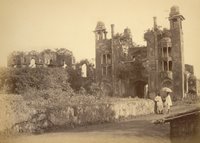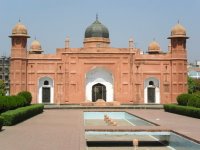 Ruins of Lalbagh Fort in 1870 during British rule |  Renovation of fort area |
 Fort renovated |  Bastion of Lalbagh fort an etching drawn by Sir Charles D'oyly'e in 1816 |
 |  |
 Bastion on south |  Gate south east of fort |
Lalbagh Fort is an incomplete Mughal palace fortress in Dhaka on the river Buriganga in the southwestern part of the old city. The river has now gone further south.
Prince Mohammad Azam son of emperor Aurangzeb during his Vice-royalty of Bengal laid the foundation of Lalbagh fort and commenced its construction in 1678 AD, but before he could complete, he was recalled by emperor Aurangzeb. His successor, Shaista Khan did not continue the work, though he stayed in Dhaka up to 1688. His daughter Pari Bibi (meaning Lady Fairy) also known as Iran Dukht wife of prince Azam died here in 1684 and this led him to consider the fort to be ominous.
For long the fort was considered to be a combination of three buildings (the mosque, the tomb of Pari Bibi and the Diwan-i-Aam), two gateways and a portion of the partly damaged fortification wall. But recent excavations by Dept of Archaeology revealed existence of other structures.
The southern fortification wall has a huge bastion in the southwestern corner. On the north of south fortification wall were the utility buildings, stable, adm block, and its western part accommodated a beautiful roof-garden with arrangements for fountains and a water reservoir. The residential part was located on the east of the west fortification wall, mainly to the south-west of the mosque.
Fortification wall on the south had 5 bastions at regular intervals two story height and the western wall had 2 bastions, the biggest one is near the main southern gate. The bastion had an underground tunnel.
The central area of the fort is occupied by three buildings - the Diwan-i-Aam and the Hammam on its east, the Mosque on the west and the Tomb of Pari Bibi in between the two - in one line, but not at equal distance. A water channel with fountains at regular interval connect the three buildings from east to west and north to south.
The water channels and the fountains, are very common features of Mughal architecture. A big square water tank is placed to the east of the Diwan-i-Aam.
The Lalbagh Fort Mosque is a beautiful three-domed mosque with a water tank for ablution.
The double storeyed Diwan-i-Aam is attached with a single storeyed Hammam on its west. The Hummam complex includes an open platform, a small kitchen, an oven, water storage area, a masonry brick bath-tub, a toilet, a dressing room and an extra room. The Hammam portion has an underground room for boiling water and a passage for sweepers.
The Tomb of Pari Bibi is the most impressive of the surviving buildings of the fort. Eight rooms surround a central square room, containing the mortal remains of Pari Bibi, which is covered by a false dome, octagonal in shape, and wrapped by brass plate. The entire inner wall of the central room was covered with white marble,
"Sir Charles D'Oyly (1781-1885)" who worked as a Collector of Dhaka during 1808-1811 published a book of his collection of sketches "The antiquities of Dacca". The publisher in London did something more than simply provide the story of Dhaka as narrated by Charles D’Oyly. They furnished a list of all the collectors who worked in the city before and after the arrival of the writer-artist, right up to 1857, the year when the Sepoy Mutiny in India occurred. It is the sketches that draw the reader’s attention. Clearly, the arrival of the English had led swiftly to a deterioration in the aesthetic charms that had given the city, in Mughal times, a distinctive appearance. It was these remnants of past grandeur that D’Oyly drew faithfully on his canvas before carrying them along with him to London to publish. Such images of Dhaka as the Hussaini Dalan, Chawkbazaar, Barokatra, Lalbagh Fort and Tongi Bridge jolt people back into an awareness of the history their ancestors have lived through. One might then suggest that a very remarkable contribution that the work makes in these times is to rekindle a sense of history in the present-day generation of Bengalis.
Prince Mohammad Azam son of emperor Aurangzeb during his Vice-royalty of Bengal laid the foundation of Lalbagh fort and commenced its construction in 1678 AD, but before he could complete, he was recalled by emperor Aurangzeb. His successor, Shaista Khan did not continue the work, though he stayed in Dhaka up to 1688. His daughter Pari Bibi (meaning Lady Fairy) also known as Iran Dukht wife of prince Azam died here in 1684 and this led him to consider the fort to be ominous.
For long the fort was considered to be a combination of three buildings (the mosque, the tomb of Pari Bibi and the Diwan-i-Aam), two gateways and a portion of the partly damaged fortification wall. But recent excavations by Dept of Archaeology revealed existence of other structures.
The southern fortification wall has a huge bastion in the southwestern corner. On the north of south fortification wall were the utility buildings, stable, adm block, and its western part accommodated a beautiful roof-garden with arrangements for fountains and a water reservoir. The residential part was located on the east of the west fortification wall, mainly to the south-west of the mosque.
Fortification wall on the south had 5 bastions at regular intervals two story height and the western wall had 2 bastions, the biggest one is near the main southern gate. The bastion had an underground tunnel.
The central area of the fort is occupied by three buildings - the Diwan-i-Aam and the Hammam on its east, the Mosque on the west and the Tomb of Pari Bibi in between the two - in one line, but not at equal distance. A water channel with fountains at regular interval connect the three buildings from east to west and north to south.
The water channels and the fountains, are very common features of Mughal architecture. A big square water tank is placed to the east of the Diwan-i-Aam.
The Lalbagh Fort Mosque is a beautiful three-domed mosque with a water tank for ablution.
The double storeyed Diwan-i-Aam is attached with a single storeyed Hammam on its west. The Hummam complex includes an open platform, a small kitchen, an oven, water storage area, a masonry brick bath-tub, a toilet, a dressing room and an extra room. The Hammam portion has an underground room for boiling water and a passage for sweepers.
The Tomb of Pari Bibi is the most impressive of the surviving buildings of the fort. Eight rooms surround a central square room, containing the mortal remains of Pari Bibi, which is covered by a false dome, octagonal in shape, and wrapped by brass plate. The entire inner wall of the central room was covered with white marble,
"Sir Charles D'Oyly (1781-1885)" who worked as a Collector of Dhaka during 1808-1811 published a book of his collection of sketches "The antiquities of Dacca". The publisher in London did something more than simply provide the story of Dhaka as narrated by Charles D’Oyly. They furnished a list of all the collectors who worked in the city before and after the arrival of the writer-artist, right up to 1857, the year when the Sepoy Mutiny in India occurred. It is the sketches that draw the reader’s attention. Clearly, the arrival of the English had led swiftly to a deterioration in the aesthetic charms that had given the city, in Mughal times, a distinctive appearance. It was these remnants of past grandeur that D’Oyly drew faithfully on his canvas before carrying them along with him to London to publish. Such images of Dhaka as the Hussaini Dalan, Chawkbazaar, Barokatra, Lalbagh Fort and Tongi Bridge jolt people back into an awareness of the history their ancestors have lived through. One might then suggest that a very remarkable contribution that the work makes in these times is to rekindle a sense of history in the present-day generation of Bengalis.
Also see Lalbagh Area and Fort Incident and
Lalbagh Fort salvaged from neglected past.

No comments:
Post a Comment